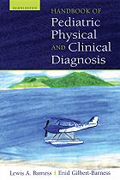
Despite the advent of powerful technological advances, the cornerstone of patient care remains the history and physical examination. In this era of lab tests and, in a system dominated by "adult medicine," the special approach to theunique examination of infants and children is often lost. In the Handbook of Pediatric Physical Diagnosis, the highly respected pediatrician Lewis Barness,and noted pediatrician and pathologist, Enid Gilbert-Barness, present clear descriptions and guidelines for the examination of the pediatric patient in an objective, analytical, and humanistic manner. With concise, clearly written text covering both common and difficult diagnoses, and aided by a wealth of tables, charts, and illustrations, this new edition includes more information on differential diagnosis, and has a new fresh look. INDICE: 1: Approach to the Patient 2: Measurements, Vital Signs 3: GeneralAppearance, Skin, and Lymph Nodes 4: Nutrition 5: Head and Neck 6: The Chest,Breast, and Respiratory 7: The Abdomen 8: Extremities, Joints, and Spine 9: Heart 10: Spleen and Liver 11: Chromosomal Disorders and Genetic Diseases 12: Hematologic Disorders 13: Infections 14: Urinary Tract 15: Genitalia 16: Endocrine 17: The Eye 18: Neurologic, Neuropsychiatric Disorders and Behavioral Disorders 19: Child Abuse 20: Examination of the Newborn 21: Adolescence 22: Appendix
- ISBN: 978-0-19-537325-7
- Editorial: Oxford University
- Encuadernacion: Rústica
- Páginas: 562
- Fecha Publicación: 01/02/2010
- Nº Volúmenes: 1
- Idioma: Inglés
